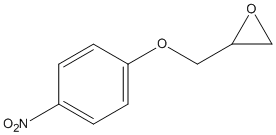pNPGE
General
Type :
Chemical_Nomenclature : 2-[(4-nitrophenoxy)methyl]oxirane
Canonical SMILES : C1C(O1)COC2=CC=C(C=C2)[N+](=O)[O-]
InChI : InChI=1S\/C9H9NO4\/c11-10(12)7-1-3-8(4-2-7)13-5-9-6-14-9\/h1-4,9H,5-6H2
InChIKey : FPIGOBKNDYAZTP-UHFFFAOYSA-N
Other name(s) : 2-[(4-Nitrophenoxy)methyl]oxirane, 1,2-epoxy-3-(4-nitrophenoxy)propane, 1,2-Epoxy-3-(p-nitrophenoxy)propane, EPNP, para-nitrophenyl glycidyl ether

Target
Families : No family
References (3)
| Title : Directed evolution of epoxide hydrolase from A. radiobacter toward higher enantioselectivity by error-prone PCR and DNA shuffling - van Loo_2004_Chem.Biol_11_981 |
| Author(s) : van Loo B , Spelberg JH , Kingma J , Sonke T , Wubbolts MG , Janssen DB |
| Ref : Chemical Biology , 11 :981 , 2004 |
| Abstract : van Loo_2004_Chem.Biol_11_981 |
| ESTHER : van Loo_2004_Chem.Biol_11_981 |
| PubMedSearch : van Loo_2004_Chem.Biol_11_981 |
| PubMedID: 15271356 |
| Gene_locus related to this paper: agrra-echA |
| Title : Enantioselective detoxication of optical isomers of glycidyl ethers - Chen_1993_Chirality_5_501 |
| Author(s) : Chen R , Nguyen P , You Z , Sinsheimer JE |
| Ref : Chirality , 5 :501 , 1993 |
| Abstract : Chen_1993_Chirality_5_501 |
| ESTHER : Chen_1993_Chirality_5_501 |
| PubMedSearch : Chen_1993_Chirality_5_501 |
| PubMedID: 8240926 |
| Title : Continuous spectrophotometric assays for cytosolic epoxide hydrolase - Wixtrom_1988_Anal.Biochem_174_291 |
| Author(s) : Wixtrom RN , Hammock BD |
| Ref : Analytical Biochemistry , 174 :291 , 1988 |
| Abstract : Wixtrom_1988_Anal.Biochem_174_291 |
| ESTHER : Wixtrom_1988_Anal.Biochem_174_291 |
| PubMedSearch : Wixtrom_1988_Anal.Biochem_174_291 |
| PubMedID: 3218741 |